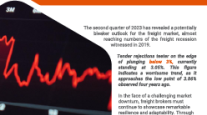Staff Reporter
Spot Market Rebalance Slows Amid Volatile Capacity

[Stay on top of transportation news: Get TTNews in your inbox.]
The spot market is struggling to rebalance as the rate of carriers exiting has slowed despite sluggish demand.
“We’ve seen a slowing in carriers leaving the industry,” said Dean Croke, principal analyst at DAT Freight & Analytics. “But we’ve seen an increase in the number of carriers joining the industry, which is a weird phenomenon because you would have thought this market is not all that healthy from a rate perspective.”
DAT found the number of carriers in the market dropped by 12% during the first quarter. Mostly, those have been carriers that entered when rates were strong but were later stuck with high equipment and insurance costs when the market slowed. This has been met with a 20% increase in new carriers during the same period that can operate more cost effectively.
“That’s unprecedented in many ways because on the flip side, there are carriers out there that are really struggling and need at least 40 to 50 cents more a mile,” Croke said. “So we’ve got this really bifurcated market right now. It’s the tale of two markets in a way.”
The Truckstop Market Demand Index usually has been hovering around 50 after the COVID-19 pandemic. It measures available freight versus trucks able to haul it. The bigger the number, the more that it is in balance. In the past six weeks, it has been in the 70s.
For week 14 in the spot market, 3 of the 4 key market indicators decreased. Here's what you need to know: 👇
⚙️ The overall Market Demand Index (MDI) rose by 4.7 points to 76.4 as load availability decreased 2.9% and truck availability declined 8.9%.
⚙️ Compared to last year… pic.twitter.com/CteBWzeLFM — Truckstop (@Trckstopdotcom) April 10, 2024
“Trucking right now is just trying to continue to seek its normal balance, but there’s some bright spots like the market demand index,” said Brent Hutto, the chief relationship officer at Truckstop. “That shows that the marketplace is getting stronger because the higher it is, that means there’s more freight in the market. And so there’s more availability within the overall transportation segment.”
We’ve seen a slowing in carriers leaving the industry. But we’ve seen an increase in the number of carriers joining the industry, which is a weird phenomenon because you would have thought this market is not all that healthy from a rate perspective.
Dean Croke, principal analyst at DAT Freight & Analytics
Image
Hutto added that there is about 15% more freight in the market than the five-year average. He believes part of that is because of the usual seasonal increase transportation experiences and bid season being over.
“We’re seeing more carriers leave the for-hire part of the marketplace,” Hutto said. “But I will say there’s some hot spots in some places … We’re seeing a pretty big increase in power-only. That’s really unique from the standpoint of a marketplace that kind of keeps evolving into hauling all kinds of freight.”

Hutto
Croke isn’t anticipating a strong recovery this year given how slowly capacity is leaving the market while demand remains fairly weak. He has seen some volume improvements in key markets but adds it has been tempered. He also believes interest rate cuts may not happen this year.
“A robust produce season alone is not going to help move the market materially, nor is one of the highest import volumes in March,” Croke said. “So we’re just not seeing demand across the board at a level that would say this market is going to turn around.
“So, you’ve got on the demand side of the equation a fairly soft freight market that’s going to be a very extended recovery period and may take the rest of this year.”
Croke also isn’t expecting a seismic shift in capacity because diesel prices came down last year, and carriers have a much longer runway to stay in the market with their record profits in 2021. He suspects many are hanging on because they are anticipating the eventual market turnaround.

Danaf
“We have not seen any signs of significant tightening yet,” said Mazen Danaf, senior economist at Uber Freight. “Route guide performance remains strong across Uber Freight’s transportation management network, while March set a new cycle low in terms of average monthly van spot rates. Some of these spot market indicators can be volatile, so we cannot draw conclusions from a couple of weeks’ worth of data.”
Danaf added that while the manufacturing sector finally hit bottom, consumer spending has softened in 2024. He also pointed out that the freight market unexpectedly added more capacity for both trucking payroll employment and Federal Motor Carrier Safety Administration authorities.

Mancini
“Our initial 2024 forecast anticipated that the spot market would return to the bottom after the 2023 holidays, but that drop was delayed by winter storms nationwide,” said Jim Mancini, vice president for North American Surface Transportation at C.H. Robinson. “Where pockets of tightness are appearing in the market today, they’re doing so in an abbreviated and somewhat volatile way. More like blips rather than indications of an early turn in the market.”
C.H. Robinson, which ranks No. 1 on the Transport Topics Top 100 list of the largest logistics companies in North America, recently altered its spot market forecast for the whole year from 4% year-over-year growth to 2% because of the slightly lower bottoming of rates during March and April.
NEW REPORT: Check out our updated forecast for trucking rates, when we expect carrier capacity to tighten again, and the ocean-shipping disruptions we see on the horizon ➡️ https://t.co/VgZk598A8W pic.twitter.com/1Uey5gXPUW — C.H. Robinson (@CHRobinson) March 21, 2024
“Our forecast continues to be for rates on average to stay fairly close to current levels until the combined effects of produce season and beverage season traditionally start to push them upward,” Mancini said. “It’s in Q3 when we expect enough carriers to have left the market that trucking supply will come down to historically normal levels.”
Want more news? Listen to today's daily briefing below or go here for more info:





